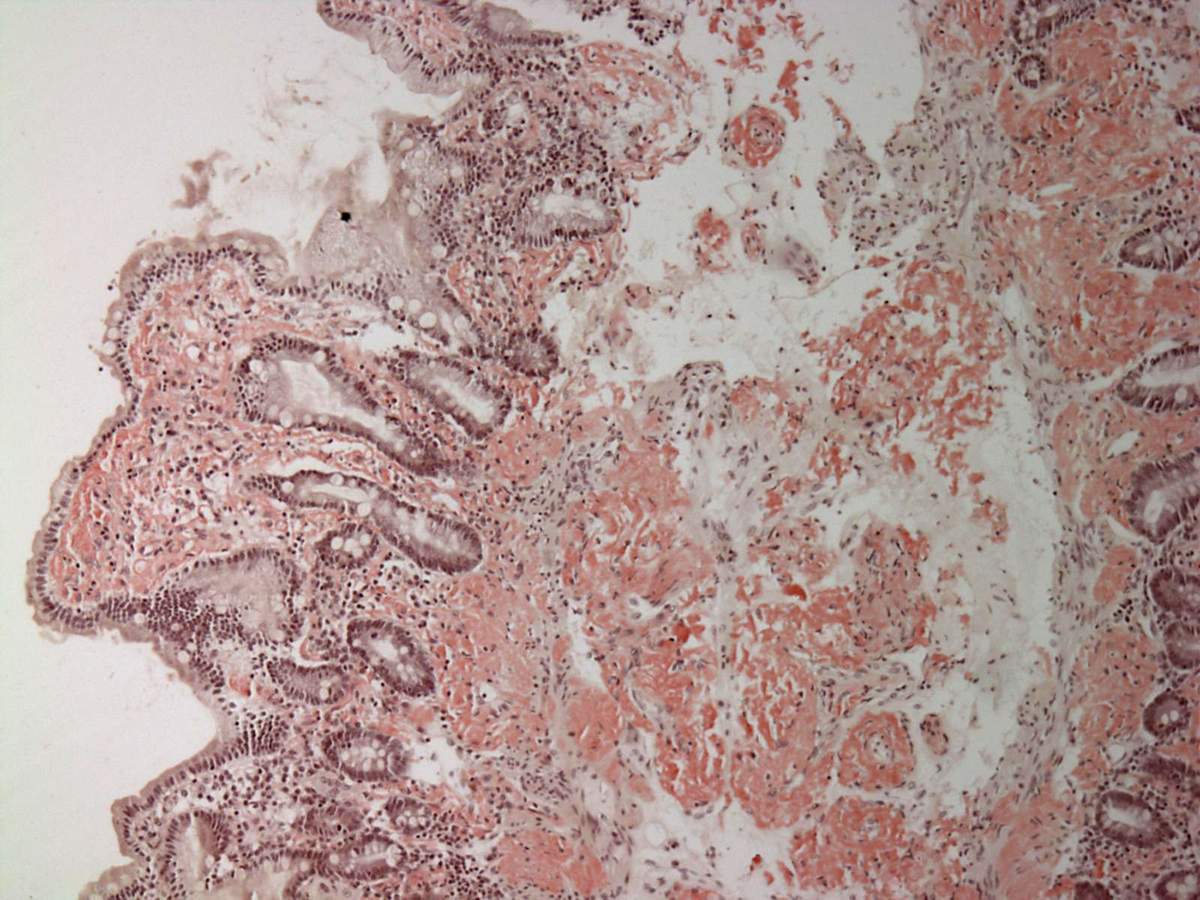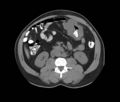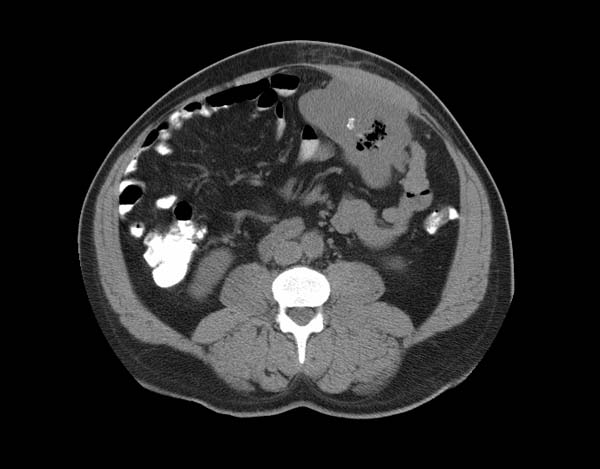Amyloidosis
| Amyloidosis | |
 | |
|---|---|
| Small bowel duodenum with amyloid deposition congo red 10X | |
| ICD-10 | E85 |
| ICD-9 | 277.3 |
| DiseasesDB | 633 |
| MeSH | D000686 |
|
Amyloidosis Microchapters |
|
Diagnosis |
|---|
|
Treatment |
|
Case Studies |
|
Amyloidosis On the Web |
|
American Roentgen Ray Society Images of Amyloidosis |
For patient information, click here
Editor-In-Chief: C. Michael Gibson, M.S., M.D. [1]; Associate Editor(s)-in-Chief: Raviteja Guddeti, M.B.B.S. [2]
Synonyms and keywords: Amyloid disease
Overview
Historical Perspective
Classification
Pathophysiology
Causes
Differentiating Amyloidosis from other Diseases
Amyloidosis should be differentiated from the following systemic diseases:
- Acute myocarditis
- Bechterew's Disease
- Bronchiectasis
- Carpal Tunnel Syndrome
- Collagen Vascular Disease
- Drug/toxic nephropathy
- Familial Mediterranean Fever
- Glomerulonephritis
- Hemodialysis Amyloidosis
- Interstitial lung diseases
- Leprosy
- Monoclonal gammopathies
- Multiple Myeloma
- Myocardial fibrosis
- Nephrotic Syndrome
- Osteomyelitis
- Peripheral neuropathy
- Restrictive cardiomyopathy
- Rheumatoid Arthritis
- Rheumatoid Polyarteritis
- Syphilis
- Systemic Lupus Erythematosus
- Tuberculosis
- Ulcerative colitis
- Vitamin deficiencies
Epidemiology and Demographics
Risk Factors
Natural History, Complications and Prognosis
Complications
Possible complications of amyloidosis include:
- Hyposplenism
- Malabsorption syndrome
- Myopathy
- Proximal renal tubular acidosis
- Renal failure
- Vascular hemostatic disorder
- Chronic brain failure
- Nephrotic syndrome
- Myocarditis
- Restrictive cardiomyopathy
- Pulmonary fibrosis
- Autonomic neuropathy
- Pericardial effusion
- Congestive heart failure
- Endocrine failure (hormonal disorder)
- Respiratory failure
- Hypogonadic hypogonadism
- Death
Prognosis
The severity the disease depends on the organs that are affected. When the heart and kidney are involved, it may lead to organ failure and death. Body-wide ( systemic) involvement can lead to death in 1 to 3 years.
Diagnosis
History and Symptoms | Physical Examination | Laboratory Findings | Electrocardiogram | X Ray | CT | MRI | Other Imaging Findings
Symptoms depend on the organs affected by the deposits. These organs can include the tongue, intestines, skeletal and smooth muscles, nerves, skin, ligaments, heart, liver, spleen, and kidneys.
Symptoms include:
- Palpitations
- Hemoptysis
- Cough
- Lightheadedness
- Fatigue
- Numbness of hands and feet
- Shortness of breath
- Skin changes
- Swallowing problems
- Swelling in the arms and legs
- Weak hand grip
- Weight loss
Other symptoms that may occur with this disease:
- Decreased urine output
- Diarrhea
- Hoarseness or changing voice
- Joint pain
- Weakness
Physical Examination
Vitals
Skin
- The most common skin findings are
- Petechiae (small red blood spots).
- Ecchymoses (small, flat blood spots that are round or irregular shape and bluish/purplish in colour)
- Waxy papular nodules can be seen around the eye lids, neck and also in the groin.
- Brittle nails.
- Edema due to heart failure
- Patches of hair loss can be seen.
Head
- Parotid gland enlargement
- Submandibular gland enlargement
Eye
- Raised intraocular pressure may be present.
Throat
Abdomen
Extremities
- Carpal tunnel syndrome
- Numbness of the fingers and toes
- Raynaud phenomenon
Laboratory Findings
- Complete blood count - may reveal anemia.
- Erythrocyte sedimentation rate - elevated
- Liver function tests
- Kidney function tests may show signs of kidney failure or too much protein in the urine (nephrotic syndrome).
- BUN level is increased.
- Serum creatinine is increased.
- Urinalysis shows protein, casts, or fat bodies.
- Bence-Jones protein (quantitative)
- Serum troponin, B-type natriuretic peptide, and beta-2-microglobulin - prognostic markers for heart failure.
- Immunoelectrophoresis - serum
- Amyloid deposits can be identified histologically by Congo red staining and viewing under polarized light where amyloid deposits produce a distinctive 'apple green birefringence'. Alternatively, thioflavin T stain may be used
- Immunohistochemical studies on the amyloid deposits - to differentiate from different types of amyloid.
- Biopsy - is needed depending on the involvement of the specific organ. e.g tongue, myocardium, skin. An abdominal fat pad aspiration, rectal mucosa biopsy, or bone marrow biopsy can help confirm the diagnosis. They reveal positive findings in 80% patients.
Electrocardiogram
- Abnormal rhythm - arrhythmias
- Low voltage recordings
Imaging
X-ray
- Coin lesion (chest x-ray)
Echocardiogram
- Echocardiogram is a valuable tool in the evaluation of the extent of heart involvement in amyloidosis. The common findings include:
- Thickened ventricular wall
- Ventricular wall motion abnormalities
CT
Gastrointestinal amyloidosis on imaging
MRI
- Cardiac MRI is used when echocardiogram fails to differentiate amyloidosis from hypertrophic cardiomyopathy.
Other Imaging Studies
- In addition, all amyloid deposits contain serum amyloid P component (SAP), a circulating protein of the pentraxin family. Radionuclide SAP scans have been developed which can anatomically localize amyloid deposits in patients.
- Tissue Doppler and myocardial strain rate imaging has been proven to be very sensitive for the assessment of myocardial dysfunction in restrictive cardiomyopathy. Doppler studies may show abnormal wall motion early in the disease process.
Treatment
There is no treatment for primary amyloidosis.
- The initial target in the treatment of this disorder is to correct the organ failure, as the disease is discovered at an advanced stage.
- Nephrotic syndrome is treated using supportive therapy and diuretics.
- Renal failure is treated with dialysis
- Heart failure is treated using diuretics
- Gastrointestinal and nerve involvement are treated symptomatically.
Treatment options with limited success include melphalan and prednisone, and colchicine.



